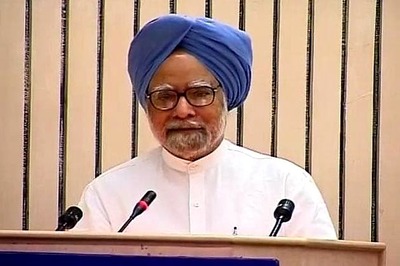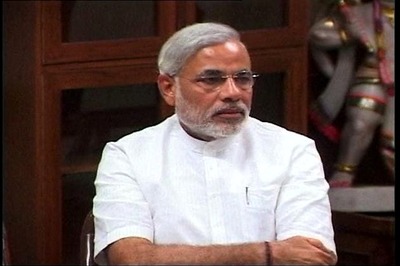
views
Crowds outside the Wisconsin State Capitol tore down two statues, attacked a state senator, threw a Molotov cocktail into a government building amid protests following the arrest of a Black man who shouted at restaurant customers through a megaphone while carrying a baseball bat.
Officers inside the Capitol used pepper spray to repel protesters who were trying to gain entry into the historic center of state government, Madison police said.
Gov. Tony Evers on Wednesday said he was prepared to activate the Wisconsin National Guard to protect state properties.
“What happened in Madison last night presented a stark contrast from the peaceful protests we have seen across our state in recent weeks, including significant damage to state property," Evers said in a statement.
The violence started Tuesday after Madison police arrested a protester who came to a restaurant across the street from the Capitol with a bat on his shoulder. Video released by Madison police shows the man, Devenore Johnson, talking through a megaphone while walking around the restaurant’s outdoor patio. He walks inside and paces through the restaurant with the bat on his shoulder, saying he’s “disturbing” the restaurant and talking about God and the police before walking out.
On another video released by police, as many as five officers can be seen taking Johnson to the sidewalk and carrying him to a police squad car after he resisted arrest. Police said the man briefly escaped from the squad car before being tackled.
Johnson was charged in 2015 with being a passenger in a stolen car, resisting an officer and theft, according to online court records. He pleaded guilty to being a passenger and was sentenced to probation. The following year he was charged with being a party to armed robbery and theft. Under a plea deal, he was sentenced to probation after pleading guilty to theft.
Police said on Tuesday night a group of 200 to 300 people gathered and entered a private condominium building where they surrounded a tow truck, forcing the driver to abandon it. The crowd broke windows in multiple buildings, threw a Molotov cocktail into the city-county building and brought down the statues on the grounds of the Capitol.
Protesters chanting for Johnson's release also broke glass at the Tommy Thompson Center, named for the former Republican governor, and smashed windows and lights at the Capitol. Early Wednesday, police in riot gear worked to clear a crowd of about 100 people that remained in the area.
One of the statues toppled, decapitated and dragged into a lake about a half-mile away was of Civil War Col. Hans Christian Heg. He was an anti-slavery activist and leader of an anti-slave catcher militia in Wisconsin who fought for the Union and died from injuries suffered during the Battle of Chickamauga.
The base of the Heg statue was defaced with graffiti Wednesday morning that read “Fire Matt Kenny,” a reference to a white Madison police officer who shot and killed 19-year-old Tony Robinson, a Black man, in 2015. Kenny said Robinson had attacked him and he feared he would take his gun. Dane County District Attorney Ismael Ozanne, who is Black, cleared Kenny of any criminal wrongdoing and he remains a Madison officer.
That death sparked protests in 2015 and simmering anger among Black activists that Kenny remains on the police force. A banner calling for justice for Robinson has been hanging over a Madison overpass for the last several days.
Madison has a long history of protests and clashes with police, dating to student-led demonstrations on the University of Wisconsin campus in the 1960s. About 100,000 people protested in 2011 over anger related to anti-union proposals from then-Gov. Scott Walker. Smaller protests are almost a weekly, and sometimes daily, fixture at the Capitol on a host of issues.
The vast majority of protests over the years have been peaceful, until now.
The other statue taken down represents Wisconsin’s motto of “Forward.” The statue had been vandalized in past protests with paint thrown on it and graffiti spray-painted on and around it.
“Forward” was first installed 125 years ago but replaced with a bronze replica in 1998. It sat prominently outside the Capitol, facing the University of Wisconsin campus and the street lined with bars, restaurants and small businesses. That corridor has been the target of much of the vandalism since the death of George Floyd on May 25 in Minneapolis after a white police officer used his knee to pin the handcuffed Black man’s neck, even after Floyd stopped moving.
The destruction followed similar unrest nationwide following Floyd’s death, but in other cities statues of Confederate soldiers and other symbols of slavery were destroyed.
Democratic state Sen. Tim Carpenter was assaulted after taking a cellphone video of protesters.
“Punched/kicked in the head, neck, ribs,” Carpenter tweeted around 4 a.m. “Maybe concussion, socked in left eye is little blurry, sore neck & ribs. 8-10 people attacked me. Innocent people are going to get killed. Capitol locked- stuck in office.Stop violence nowPlz!”
Protester Ebony Anderson-Carter told the Wisconsin State Journal that the destruction was spurred in part by state and local officials ignoring calls for change. The Forward and Heg statues stand for good causes, she said, but their display creates a “false representation of what this city is,” she said.
The violence drew bipartisan outrage from Wisconsin politicians.
"I am saddened at the cowardice of Madison officials to deal with these thugs,” Republican Assembly Speaker Robin Vos tweeted as the statues were being torn down.
Madison Alderman Paul Skidmore said he's upset with Mayor Satya Rhodes-Conway for not condemning the violence and showing more support for police.
“They're destroying our public monuments," Skidmore said. “They're destroying our government fabric. They're crossing that line with impunity. The mob has become very bold. They see they can get away with a little and they inch forward more and more. (Downtown Madison) is a battle zone right now and I fear for my city.”
Rhodes-Conway issued a statement calling the latest protests “exceedingly dangerous” and saying police are investigating. She also cited efforts the city has undertaken since Floyd's death to better control police, including creating a police auditor and a civilian police oversight committee.
“Everyone - police, protester, elected official, business owner, resident - everyone must find it within themselves to show compassion and kindness for each other, and to care about each other’s safety and well-being,” the mayor said.




















Comments
0 comment